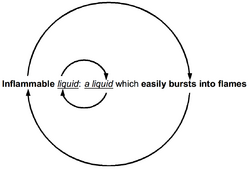Fallacies of definition
Topic: Philosophy
 From HandWiki - Reading time: 4 min
From HandWiki - Reading time: 4 min
Fallacies of definition are the various ways in which definitions can fail to explain terms. The phrase is used to suggest an analogy with an informal fallacy.[1] Definitions may fail to have merit, because they: are overly broad, use obscure or ambiguous language, or contain circular reasoning; those are called fallacies of definition.[2] Three major fallacies are: overly broad, overly narrow, and mutually exclusive definitions,[3] a fourth is: incomprehensible definitions,[4] and one of the most common[5] is circular definitions.[6]
Circularity

If one concept is defined by another, and the other is defined by the first, this is known as a circular definition, akin to circular reasoning: neither offers enlightenment about what one wanted to know.[7] "It is a fallacy because by using a synonym in the definiens the reader is told nothing significantly new."[5]
A straightforward example would be to define Jew as "a person believing in Judaism", and Judaism as "the religion of the Jewish people", which would make Judaism "the religion of the people believing in Judaism".
Incongruity: overly broad or narrow
A definition intended to describe a given set of individuals fails if its description of matching individuals is incongruous: too broad (excessively loose with parameters) or too narrow (excessively strict with parameters). For example, "a shape with four sides of equal length" is not a sufficient definition for square, because squares are not the only shapes that can have four sides of equal length; rhombi do as well. Likewise, defining rectangle as "a shape with four perpendicular sides of equal length" is inappropriate because it is too narrow, as it describes only squares while excluding all other kinds of rectangles, thus being a plainly incorrect definition.
If a cow were defined as an animal with horns, this would be overly broad (including goats, for example), while if a cow were defined as a black-and-white quadruped, this would be both overly narrow (excluding: all-black, all-white, all-brown and white-brown cows, for example)[3] and overly broad (including Dalmatians, for example).
Obscurity
Definitions can go wrong by using ambiguous, obscure, or figurative language. This can lead to circular definitions. Definitions should be defined in the most prosaic form of language to be understood, as failure to elucidate provides fallacious definitions.[7] Figurative language can also be misinterpreted. For example, golden eyes in a biography may lead the reader to think that the person was fictional.
An example of obscurity is Samuel Johnson's definition for oats: "A grain, which in England is generally given to horses, but in Scotland supports the people."[8] The thing defined (oats) should be pointed out rather than remain obscure.
Mutual exclusivity
The definition completely excludes what is being defined. For example, a cow might be defined as a flying animal with no legs.[3] In reality a cow has legs and cannot fly, but this example claims to define a cow using a definition that is opposite to what a cow actually is. "Cow" and "flying animal with no legs" are mutually exclusive to each other: they cannot refer to the same thing.
Self-contradictory requirements
Definitions may fail by imposing conflicting requirements, making it impossible for them to apply to anything at all. For example, a cow being defined as a legless quadruped, or the term dynamic equilibrium – equilibrium state cannot be dynamic. These requirements may also be mutually exclusive.[citation needed]
Definist fallacy
The definist fallacy is a logical fallacy, coined by William Frankena in 1939, that involves the definition of one property in terms of another.[9][clarification needed]
See also
- Philosophy:Equivocation – Misleading use of a term with multiple meanings
- Fallacy – Argument that uses faulty reasoning
- Fallacy of division – Fallacy
- Philosophy:Formal fallacy
- Philosophy:Inscrutability of reference – Philosophical thesis by Willard Van Orman Quine
- Philosophy:Persuasive definition – Stipulative, biased definition of a term
References
- ↑ Kale, Rekhaa (2015-10-25). "BLS LOGIC 1: CHAPTER 8. DEFINITION". http://blslogic1.blogspot.com/2015/10/chapter-8-definition.html.
- ↑ Gibbon, Guy (2013). Critically Reading the Theory and Methods of Archaeology: An Introductory Guide. Rowman & Littlefield. ISBN:9780759123427.
- ↑ 3.0 3.1 3.2 Potter, Karl H. (1991). Presuppositions of India's Philosophies, p.87. Motilal Banarsidass. ISBN:9788120807792. "Under-extension", "over-extension", and "mutual exclusion".
- ↑ Chakraborti, Chhanda (2007). Logic: Informal, Symbolic and Inductive, p.54-5. PHI Learning. ISBN:9788120332485. "Too wide", "too narrow", "incomprehensible", and "conflicting".
- ↑ 5.0 5.1 5.2 Hughes, Richard E. and Duhamel, Pierre Albert (1966/1967). Principles of rhetoric/Rhetoric principles and usage, p.77/141. 2nd edition. Prentice-Hall. "Using in the definition itself the word to be defined or a close synonym of it."
- ↑ Schipper, Edith Watson and Schuh, Edward (1960). A First Course in Modern Logic, p.24. Routledge. "Incongruous", "circular", "negative", and "obscure or figurative".
- ↑ 7.0 7.1 "Circular Definition". http://onegoodmove.org/fallacy/circle.htm. Accessed September 2, 2014.
- ↑ Johnson, Samuel (1755), A Dictionary of the English Language, http://johnsonsdictionaryonline.com/?p=3471
- ↑ Bunnin, Nicholas; Yu, Jiyuan (2008), The Blackwell Dictionary of Western Philosophy, John Wiley & Sons, p. 165, ISBN 978-0-470-99721-5, https://books.google.com/books?id=LdbxabeToQYC&pg=PA165
 |
37 views | Status: cached on July 20 2024 00:17:34
↧ Download this article as ZWI file
 KSF
KSF